
Key points for choosing stainless steel sinks: making kitchen “washing” easier
Stainless steel sinks have excellent materials and func [...]
Stainless steel sinks have excellent materials and functions, so stainless steel sinks are usually installed in kitchen spaces. When purchasing stainless steel sinks, you need to pay attention to the key points when purchasing and choose a stainless steel sink of good quality.
Thickness: The thicker the stainless steel sink, the better. When purchasing a sink, you should also consider the toughness of the sink. , The thickness of 304 stainless steel sinks should be between 0.8-1.0mm. Sinks of this thickness can avoid damage to various porcelain utensils caused by impacts to the greatest extent. However, it should also be avoided that the sink material is too thin, which will affect the quality of the sink.
Frame: The frame of the sink should be light and thin. Such a sink will have the largest washing space and the smallest appearance size, and can also prevent water from splashing out of the sink.
Weight: Sinks made of regular stainless steel are generally heavier, while fake and inferior stainless steel, such as chrome-plated steel plates, are lighter.
Process: The processes of stainless steel sinks include welding and one-piece molding. There are two types of welding methods. One is the circumferential welding of the basin and the panel. Its advantage is that the shape is beautiful, the weld is not easy to find after strict treatment, and the surface of the sink is flat and smooth. The disadvantage is that the strength is average. The other is the butt welding of two single basins into one. Its advantage is that the basin and the panel are stretched and formed as one, which is strong and durable. Its disadvantage is that the welding marks are easy to see and the flatness is slightly poor.
Depth: The body of the sink suitable for home use is more than 180mm. Such a sink has a large capacity and has a splash-proof effect.
Surface flatness: A sink with poor flatness, in addition to affecting the appearance, is also prone to water seepage and scale accumulation. The method of testing the flatness of the sink can keep the line of sight consistent with the plane of the sink, the edge of the sink is not protruding, not warped, and the error is less than 0.1mm.
Sink accessories: The quality of the sink's drain pipe and drain outlet directly affects the use of the sink. The better drain pipe material should be PP or UPVC with high sealing, elasticity, heat resistance, crack resistance, easy installation, no clogging, and no water seepage. The drain outlet should have steel ball positioning, extrusion seal and table-controlled drainage, strong sealing, convenient and fast water storage, automatic filtering of impurities, avoid clogging of the drain pipe, use high-quality rubber, and not easy to wear. Fastening seals should be fastened with self-tapping screws to ensure sealing and safe and quick operation.
Noise reduction treatment: There is usually a silencer pad or silencer coating at the bottom of the sink, which also has the function of preventing water seepage and air leakage


Please login to write a comment after